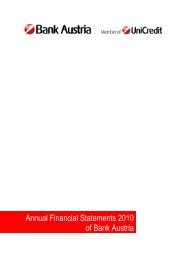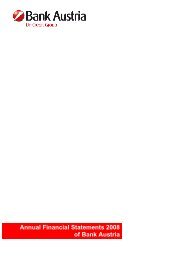Annual Financial Statements 2011 of Bank Austria
Annual Financial Statements 2011 of Bank Austria
Annual Financial Statements 2011 of Bank Austria
You also want an ePaper? Increase the reach of your titles
YUMPU automatically turns print PDFs into web optimized ePapers that Google loves.
Management Report <strong>of</strong> UniCredit <strong>Bank</strong> <strong>Austria</strong> AG<br />
Major balance sheet items – comparison <strong>of</strong> year-end levels<br />
<strong>2011</strong>/2010<br />
On the assets side, cash in hand and balances with central<br />
banks and postal giro <strong>of</strong>fices declined by € 185.9 m or 15.2% to<br />
about € 1 bn. Treasury bills and similar securities eligible for<br />
repurchase transactions declined by € 250.7 m or 7.3% from the<br />
level a year earlier; but at € 3.2 bn, they were a significant liquidity<br />
reserve.<br />
Loans and advances to credit institutions were € 22.9 bn, down<br />
by € 209 m or 0.9% from the year-end 2010 level. This reflects a<br />
reduction <strong>of</strong> domestic interbank business (–19.2%, mainly<br />
denominated in foreign currency). Loans and advances to foreign<br />
credit institutions, on the other hand, rose slightly (by 1.4%, mainly<br />
denominated in euro) although export credits declined. The<br />
amounts <strong>of</strong> the changes are small compared with the large total<br />
volume. At the end <strong>of</strong> <strong>2011</strong>, 91% <strong>of</strong> interbank loans were loans and<br />
advances to foreign credit institutions, reflecting the significance <strong>of</strong><br />
funding for banks within the Group.<br />
Loans and advances to customers rose by € 1.4 bn or 2.1% to<br />
€ 68.1 bn after loan loss provisions (the gross amount rose by<br />
2.3% to € 70.6 bn). Overall (domestic and foreign customers, all<br />
currencies), mortgage loans recorded the strongest growth<br />
(+6.1%), followed by local-authority loans (+5.0%). Low-volume<br />
loans to private individuals were down by 9.3%. The total amount<br />
<strong>of</strong> other loans (€ 47.1 bn or 69% <strong>of</strong> total lending volume) rose by €<br />
1.5 bn or 3.3%. Export loans remained at a stable level. Domestic<br />
borrowers accounted for three-quarters <strong>of</strong> total loans and advances<br />
(€ 50.8 bn), slightly more (+1.2%) than at the end <strong>of</strong> 2010. Loans<br />
and advances to foreign borrowers increased by 7% in <strong>2011</strong>.<br />
Foreign currency loans were no longer actively <strong>of</strong>fered by the bank;<br />
the volume <strong>of</strong> such loans rose as the respective currencies<br />
continued to appreciate (currency translation effects).<br />
Bonds and other fixed-income securities – almost all <strong>of</strong> which were<br />
securities issued by non-public issuers – rose by € 3.1 bn or 34.2%<br />
to € 12.1 bn. The increase was mainly due to the acquisition <strong>of</strong><br />
foreign euro-denominated securities.<br />
On the liabilities side, amounts owed to credit institutions were<br />
up by € 1.7 bn or 5.7% to € 31.9 bn, which mainly reflects the<br />
increase in repurchase transactions.<br />
As at 31 December <strong>2011</strong>, amounts owed to customers were<br />
€ 46.3 bn (up by € 381 m or 0.8%). Within the total amount,<br />
savings deposits rose slightly, to € 16.7 bn. The increase <strong>of</strong> 0.6%<br />
to € 29.6 bn in other liabilities within this item reflects a reduction <strong>of</strong><br />
time deposits in favour <strong>of</strong> deposits repayable on demand. This<br />
development may be explained by declining opportunity cost in<br />
view <strong>of</strong> the low interest rate environment.<br />
Debts evidenced by certificates rose by € 2.9 bn or 13.8% to<br />
€ 23.9 bn in <strong>2011</strong>, mainly as a result <strong>of</strong> the increase in new issues<br />
<strong>of</strong> mortgage bonds and public-sector mortgage bonds (previously<br />
local-authority bonds); the total amount <strong>of</strong> mortgage bonds and<br />
public-sector mortgage bonds rose by € 3.2 bn or almost two-thirds<br />
(+63%). At € 14.6 bn, bonds remained the largest sub-item within<br />
debts evidenced by certificates, but the total amount outstanding<br />
rose at a lower rate (+5%). Mortgage bonds are covered bonds and<br />
were therefore easier to place in the market; they were also seen<br />
as a lower-cost funding alternative by the bank. Money market<br />
instruments such as commercial paper and CDs, which were <strong>of</strong><br />
significance in commercial international business in previous years,<br />
continued to decrease substantially (–62%).<br />
Other liabilities, mainly comprising trading liabilities, were down<br />
by € 659.5 m or 41.5% to € 931 m.<br />
Provisions increased by € 472.5 m to € 4.6 bn in the reporting<br />
year. The major part (68%) related to provisions for severance<br />
payments and pension provisions. The total amount <strong>of</strong> other<br />
provisions (+ € 393.9 m to € 1,467.1 m) included provisions for<br />
taxes, for pending losses on lending and securities business, for<br />
risks associated with equity interests, and for litigation risks and<br />
guarantee obligations.<br />
Subordinated liabilities declined by € 176 m or 6.3% to € 2.6 bn.<br />
As a result <strong>of</strong> the release <strong>of</strong> reserves, capital and reserves<br />
(equity) – including subscribed capital, capital reserves and<br />
revenue reserves as well as the reserve pursuant to Section 23 (6)<br />
<strong>of</strong> the <strong>Austria</strong>n <strong>Bank</strong>ing Act – declined to € 14 bn, which represents<br />
11.2% <strong>of</strong> the balance sheet total.<br />
Pr<strong>of</strong>it and loss account for <strong>2011</strong><br />
Overview: The pr<strong>of</strong>it and loss account for the reporting period<br />
reflects various developments: economic trends were positive<br />
although growth weakened as the year progressed; the interest<br />
rate environment became increasingly difficult; the government<br />
debt crisis caused uncertainty among customers; and divergent<br />
business trends at UniCredit <strong>Bank</strong> <strong>Austria</strong> AG’s banking<br />
subsidiaries in CEE resulted in lower dividend income. Positive<br />
factors in commercial banking business included the fact that after<br />
the decline in the provisioning charge in the previous year, net<br />
expenses for the disposal and valuation <strong>of</strong> loans and advances<br />
were again significantly reduced across all customer segments. But<br />
a number <strong>of</strong> special factors had a strong impact on the pr<strong>of</strong>it and<br />
loss account. These included the bank levy (– € 75 m), write-downs<br />
on Greek government bonds (– € 263 m) and adjustments <strong>of</strong> the<br />
book values <strong>of</strong> equity interests as part <strong>of</strong> a general reassessment<br />
<strong>of</strong> the outlook for several banking subsidiaries (– € 419.4 m net <strong>of</strong><br />
income from the valuation and disposal <strong>of</strong> equity interests). The<br />
above-mentioned non-operating items had a combined negative<br />
impact <strong>of</strong> almost € 757 m, which was not <strong>of</strong>fset by movements in<br />
the other items.<br />
On the income side, credit demand in <strong>2011</strong> was low after years <strong>of</strong><br />
strong growth; this development reflected the economic slowdown,<br />
with low levels <strong>of</strong> investment activity in the business sector, and the<br />
favourable liquidity position <strong>of</strong> corporate customers. Moreover, the<br />
yield curve flattened during the year, reducing income generated<br />
from maturity transformation. Against this background, the bank<br />
achieved a significant increase in net interest income in <strong>2011</strong>:<br />
although interest expenses rose more strongly than interest income<br />
because <strong>of</strong> the higher interest rate spreads which banks had to<br />
pay, net interest income rose by 6.2% to € 1,390 m, accounting for<br />
53% <strong>of</strong> operating income (2010: 46%). But revenue trends were<br />
impacted by uncertainty and risk aversion among institutional and<br />
private investors. In combination with structural factors, including a<br />
further decline in derivatives business, this led to a decrease <strong>of</strong><br />
18.0% in net fee and commission income. Dividend income<br />
was also lower, not least because CEE banking subsidiaries’<br />
balance sheets were strengthened. Overall, operating income<br />
declined by € 226 m or 7.9% to € 2,615 m. After deduction <strong>of</strong><br />
operating expenses, which rose by 6.8% to € 1,802 m, operating<br />
results amounted to € 812.4 m (down by € 340 m or 29.5%). The<br />
items between operating results and results from ordinary business<br />
activities were a net expense <strong>of</strong> over one billion euros (€ 1,199 m),<br />
which was composed <strong>of</strong> net income/expenses from the disposal<br />
and valuation <strong>of</strong> loans and advances and securities (– € 566 m),<br />
essentially the provisioning charge for lending business, and net<br />
<strong>Bank</strong> <strong>Austria</strong> – <strong>Annual</strong> <strong>Financial</strong> <strong>Statements</strong> <strong>2011</strong> 189
















